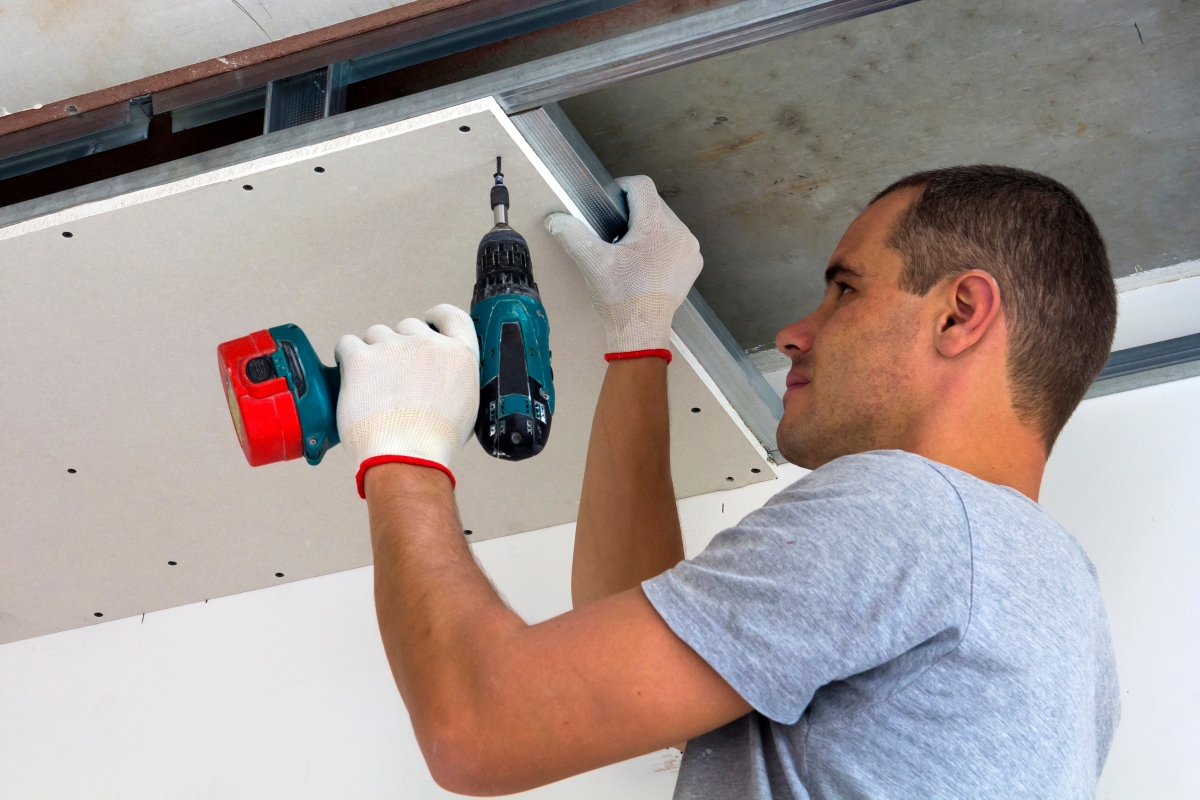Career Overview
Plasterers apply finish and maintain and restore plaster or similar materials on interior and exterior walls, ceilings and building partitions to produce plain or decorative surfaces. Drywall installers and finishers install and finish drywall sheets and various types of ceiling systems. Lathers install support framework for ceiling systems, interior and exterior walls and building partitions.
People in these occupations:
- Work for construction companies and plastering, drywalling and lathing contractors
- May be self-employed
- Should be able to work both independently and in a team setting
- Should have good manual dexterity, good hand-eye coordination and a good eye for detail
- Should also be comfortable working at heights from ladders or scaffolding
- Should be able to lift heavy objects (up to 20 kilograms)
- Should have good math skills
Job Titles
Duties
Plasterers, drywall installers and finishers and lathers are three closely related trades that build and finish walls in commercial and residential construction. These workers are involved in the application and finishing of such materials as fireproofing, thin wall, veneer plaster, rigid insulation and patent texturing materials.
Plasterers:
- Clean and prepare surfaces
- Mix plaster ingredients in trough to desired consistency
- Apply, level and smooth coats of plaster using trowels, floats, brushes and spraying equipment
- Trowel or spray coats of stucco over exteriors of buildings to form weatherproof surfaces
- Finish corners and angles and create decorative designs in finish coat, if required
- Cure freshly plastered surfaces
- Mould and install ornamental plaster panels, cornices and trim
- Spray acoustic materials or texture finish over walls and ceilings
Drywall installers and finishers:
- Measure, cut and fit drywall sheets for installation on walls and ceilings
- Position and secure sheets to metal or wooden studs or joists
- Cut and install metal corner beads to protect exterior corners
- Fill joints, nail indentations, holes and cracks with joint compound using trowel and broad knife
- Tape over joints using taping machine and embed tape in compound
- Smooth out excess compound and allow coat to dry
- Apply successive coats of compound and sand seams and joints
- Fabricate and install suspended metal ceiling grids and place in panels to form acoustical and coffered ceilings
The work of these two groups varies. For example, finishers do not install board, they finish it.
Lathers:
- Prepare wall and ceiling layouts
- Install metal stud framing and furring for interior drywall or plaster walls and ceilings, using hand and power tools
- Attach metal or gypsum lath to studs or furring using nails, screws, clips or wire ties
- Cut openings in lath for heating and ventilation piping, ducts and electrical outlets
- Install corner beads and wire mesh around beams to which plaster is to be applied
- May install acoustic tile, hangers for suspended ceilings and metal studs for composition wallboard or lath
Earnings
Earnings is income that workers receive in exchange for their labour. Depending on the type of employment, earnings can be in the form of wages (hourly), salaries (fixed monthly or annual) or self-employed earnings.
Work Environment
# Workers Employed
4,120% Employed Full Time
43%Plasterers, drywall installers and finishers and lathers typically work a standard 40-hour work week; however, some overtime may also be required to complete projects and meet deadlines.
Drywall installers and lathers usually work indoors, and may use ladders or scaffolding. Plasterers may work either indoors or outdoors, and may also work at heights using ladders or scaffolding. Plasterers, drywall installers and finishers may work in confined spaces and be exposed to dust and debris.
Workers take safety precautions when working on ladders or scaffolding to decrease risk of injury from falls. Workers are also required to lift heavy objects, which increases the risk of back injury.
Career Pathways
With education and experience, workers may progress to supervisory positions or they may start their own businesses. They may also become construction estimators, project managers or contractors.
Occupational Interests
It’s important to understand what kinds of occupations align with your interests.
For more about occupational interests visit Skills for the Future Workforce > Characteristics.
Here are the top occupational interest(s) for this career profile:
Education, Training and Skills
Completion of secondary school is usually required. As well, completion of a three- or four-year apprenticeship program in plastering, drywalling or lathing or a combination of more than three years of work experience and some high school, college or industry courses in plastering, drywalling or lathing is usually required, depending on the occupation. Apprenticeship programs:
- Can be started in secondary school, through entry-level training at colleges and technical institutes, or by direct entry
- Require workers to find a sponsor employer who is willing to participate in the program
While trade certification is not mandatory in B.C., it may increase job opportunities. Trade certification requires:
- Completion of a four-year apprenticeship program or a combination of more than five years work experience and some high school, college or industry courses
Interprovincial trade certification (Red Seal certification) is also available to qualified lathers through SkilledTradesBC. Once individuals pass the interprovincial exam (the final exam for this trade), they will achieve certification and will automatically have a Red Seal endorsement. For more information please see SkilledTradesBC's website at https://skilledtradesbc.ca.
Drywall finishers who are certified for that occupation by a regulator elsewhere in Canada can apply for the same certification from the regulator in B.C. Under the terms of the Canadian Free Trade Agreement (CFTA), most applicants who are transferring their credentials from elsewhere in Canada will not be required to complete additional training or testing. However, the B.C. regulator may ask applicants to provide further information such as a letter of good standing, references, or criminal record check.
For those who trained outside of Canada and never received certification from any Canadian jurisdiction, a full assessment is likely needed. Most occupational regulators have a process for assessment and recognize internationally trained applicants.
Contact SkilledTradesBC for details on how to apply for certification in B.C.
For information about labour mobility in Canada, visit www.workersmobility.ca.
View a list of Professional Regulatory Authorities in B.C.
Trades training resources
Visit our trades training page at www.workbc.ca/trades to learn about apprenticeship and trades training in B.C.
Education programs in B.C.

Top Skills
Every job calls for a certain set of skills. Knowing those skills is the first step in finding a good career fit.
Here, you will find the 10 most relevant workplace skills. Some are more important to achieving success in a certain career than others. These skills may come naturally to you or you may need to gain them through education, training and experience.
See the list of work-related skills below, ranked in order of importance for this career. Check out the list and see if this career matches your skills—take that first step!
Keeping track of and assessing your performance, other individuals, or organizations to make improvements or take corrective action.
Talking to others to share information effectively.
Managing one’s own time and the time of others.
Giving full attention to what other people are saying, taking time to understand the points being made, asking questions as appropriate, and not interrupting at inappropriate times.
Using logic and reasoning to identify the strengths and weaknesses of alternative solutions, conclusions or approaches to problems.
Adjusting actions in relation to others' actions.
Considering the relative costs and benefits of potential actions to choose the most appropriate one.
Being aware of others’ reactions and understanding why they react as they do.
Understanding written sentences and paragraphs in work-related documents.
Watching gauges, dials or other indicators to make sure that a machine is working properly.
Labour Market Statistics
Discover data, facts and information that have been gathered and analyzed. Learn about the characteristics of the economy and labour market in B.C.
Employment
Find out about employment types and trends by region and industry.
Employment
4,120Employment by Region







| Region | Employment | % Employment of this Occupation |
|---|---|---|
| Cariboo | 90 | 2.2% |
| Kootenay | 115 | 2.8% |
| Mainland/Southwest | 2,435 | 59.2% |
| North Coast and Nechako | 20 | 0.5% |
| Northeast | 15 | 0.4% |
| Thompson-Okanagan | 675 | 16.4% |
| Vancouver Island/Coast | 760 | 18.5% |
Labour Market Outlook
The B.C. Labour Market Outlook is a 10-year forecast of the expected supply and demand for labour in the province. It’s usually updated every year. The purpose is to provide British Columbians with the knowledge to make informed decisions on careers, skills training, education and hiring.
Forecasted Job Openings (2025-2035)
1,360Forecasted Job Openings
Forecasted Employment Growth Rate
Composition of Job Openings
Job Openings by Region (2025-2035)







| Region | Job Openings | Avg. Annual Employment Growth |
|---|---|---|
| Cariboo | 30 | 0.6% |
| Kootenay | 10 | -1.5% |
| Mainland/Southwest | 870 | 1.4% |
| North Coast and Nechako | Not available | Not available |
| Northeast | 0 | -0.8% |
| Thompson-Okanagan | 230 | 0.5% |
| Vancouver Island/Coast | 210 | 0.7% |
Industry Highlights
Learn about the opportunities in B.C.'s major industries, including employment trends, earning potential, locations of work and more.
Forecasted Job Openings by Industry
| Industry | Job Openings (2025-2035) |
|---|---|
| Construction | 1,310 |
| Information, Culture and Recreation | 10 |
| Business, Building and Other Support Services | 10 |
| Professional, Scientific and Technical Services | 10 |
| Accommodation and Food Services | 10 |
Insights from Industry
Due to the large size of this occupational group, there will be numerous opportunities for work in this profession.
Industry sources report that the recent economic downturn reduced the demand for these workers, although this is expected to change as the economy improves. Demand for workers in this occupational group will be driven primarily by construction activity and the need to replace workers who retire.
Resources
-
Association of Wall & Ceiling Contractors (AWCC)www.wallandceiling.net/home.asp
-
BC Building Tradeswww.bcbuildingtrades.org
-
BC Wall & Ceiling Association (BCWCA)www.bcwca.org
-
British Columbia Construction Association (BCCA)www.bccassn.com
-
BuildForce Canadawww.buildforce.ca/en
-
Careers in Constructionwww.careersinconstruction.ca
-
Finishing Trades Institute of BC (FTI BC)ftibc.ca
-
Homebuilders Association Vancouver (HAVAN)havan.ca
-
IUPAT DC38 – The Finishing Tradesdc38.ca
-
National Plasterers Council (NPC)www.npconline.org
-
Operative Plasters' and Cement Masons' International Associationwww.opcmia.org
-
SkilledTradesBCskilledtradesbc.ca/







